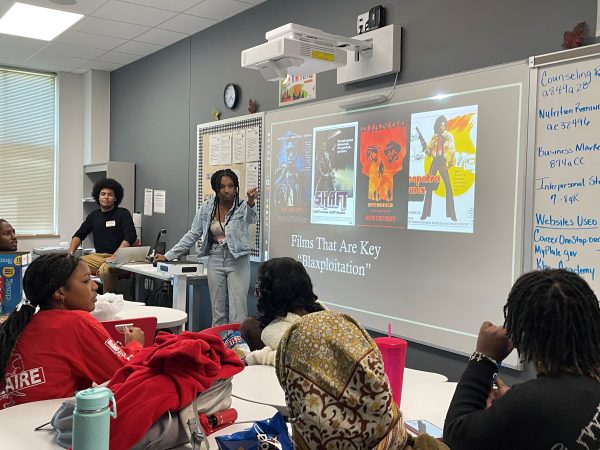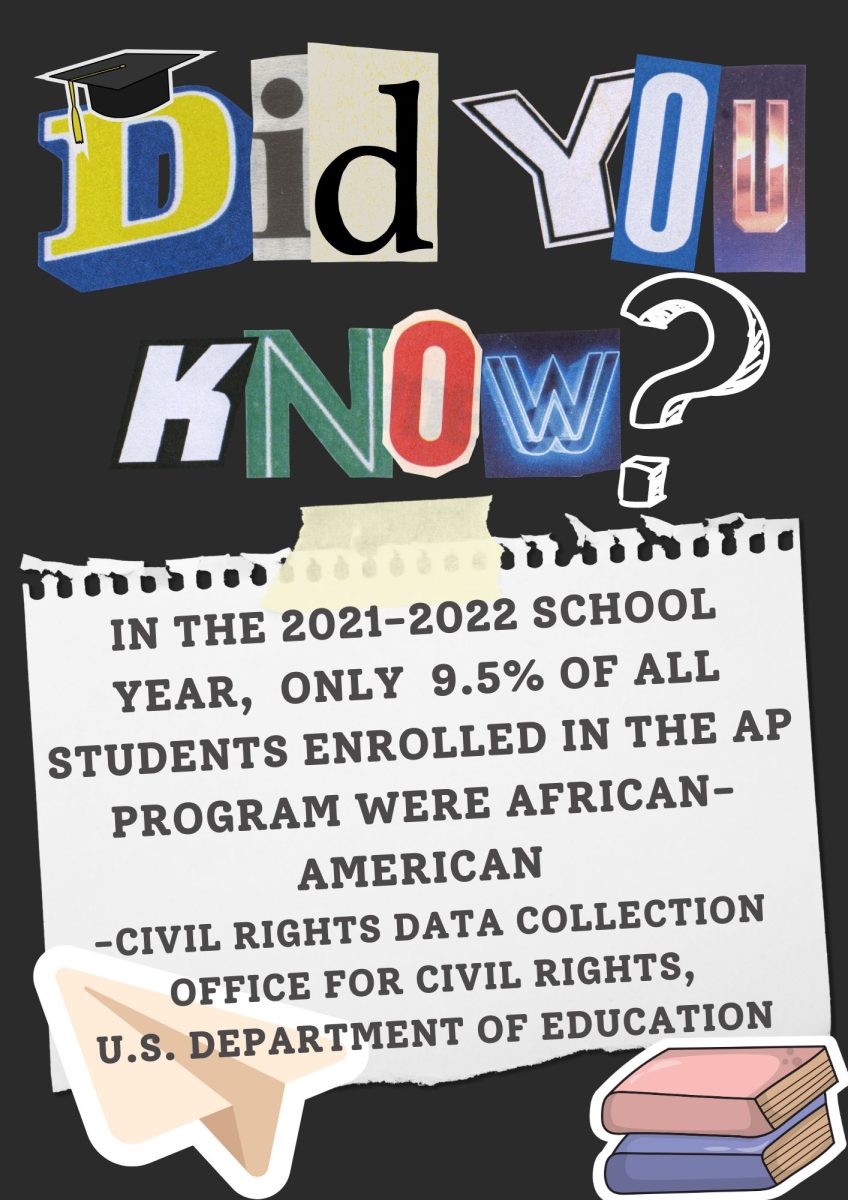Once again, I was outnumbered.
It was the first day of school, and I witnessed the same thing I’ve come to notice since freshman year: a lack of Black representation in educational spaces. My AP English Language and AP Biology class had three Black students including myself, and AP US History had four Black students, later dropping to three.
Despite this, I was beyond ecstatic to find out I could take AP African-American Studies as a junior or senior, only to be met with gratifying disappointment: there’s no such thing at Bellaire.
As minorities, we often find ourselves fighting for our spot in spaces that otherwise wouldn’t respect, accept or acknowledge us for who we are rather than who we’re painted out to be. The truth of the matter is, I’m usually one of the three or four Black students in these honor classes.
This is a common issue, as according to the U.S. Department of Education Office for Civil Rights, only 29% of Black students enrolled in at least one AP course between 2013 to 2014. According to the College Board, of the 2013 graduating class, only 9.2% of test takers were African-American and only 4.6% of those students passed the exams with a score of at least 3 out of 5.
One may consider this disproportionality a coincidence or a choice, but Black students are often doubted and underrepresented in the classroom and curriculum. When we are taught about Black folk in our classes, we are taught about our enslavement and the oppression we face as a people rather than the accomplishments and progress that we have made. If Black people are positively represented in the classroom, then it’s solely during Black History Month, and we’re taught about the same most popular civil rights leaders like Martin Luther King Jr. every year since elementary school.
This issue is increasingly becoming urgent, as since Jan. 1, there has been a ban on DEI (diversity, equity and inclusion) initiatives at the University of Texas at Austin, and lawmakers in nearly 20 states are pursuing similar bans. These initiatives at UT Austin included their Multicultural Center and other culturally significant spaces. They have taken it as far as to change the name of the university’s Division of Diversity and Community Engagement to the Division of Campus and Community Engagement as well as the The Gender and Sexuality Center to the Women’s Community Center.
This isn’t simply a name change. It’s an erasure of identity and community on a massive scale.
It’s scary to know that Texas’ second most populated school can adopt these senseless policies without there being enough uproar to challenge them. Even worse, UT Austin only has a Black student population of 4.5% and a Black staff population of 5.3% in a state with a 13.4% Black population.
On the other hand, Rice University is taking the steps to ensure that diversity and inclusion efforts are not erased or suppressed. Rice’s DEI office has implemented required diversity courses, community-based programs aimed at increasing faculty diversity and a proposal to add dozens of Black faculty and a new space on campus for Black students. These are the steps that need to be taken to secure our spot as African-Americans in these higher level educational institutions and environments.
We must create more Black-led spaces. Canvis Edwards, CTE teacher and sponsor of the African-American Association, suggested that this has been an ongoing effort.
“We’re still trying to work with other kids on campus to join and have multiple African-American associations and African-American organizations that can work all together,” Edwards said. “We don’t just need a BSU or an AAA, … we need 20 or 30 organizations that can work with African-American children. AAA can no longer continue to be that only institution anymore.”
Clubs and initiatives such as the African-American Association are crucial for the development of Black students and communities in general. At their meetings, topics such as Black history, culture and representation are conversed in a manner that is inviting and unique to the Black diaspora.
In one meeting, senior and AAA treasurer Samiya Ellis discussed the importance of Black filmmakers and representation of African-Americans in the film industry, suggesting minorities “should be included in the room” as we consistently see “negative depictions of minorities in film.” Discussions like these are infinitely important as they provide a safe space for potential Black creatives in the film industry to gain insight and inspiration without feeling judged or discredited.

Imagine if these conversations could be held about every career option and interest. Imagine the endless possibilities of upliftment, learning opportunities and inspiration fostered in these spaces, further encouraging the inclusion of Black students in rigorous classes and courses that could further enrich these passions.
Imagine if every minority community, often made to feel small and incapable, took the initiative to ensure that every member was receiving the highest level of education.
We need to create more positive representation of the Black students on campus; more programs, more clubs, increased participation in honor classes, even more Black members in Three Penny Press. Doing so can guarantee a promising future for the Black community, as we have been denied and discredited time and time again. Let’s do our best not to continue this cycle.
This story was originally published on Three Penny Press on March 3, 2024.






























![IN THE SPOTLIGHT: Junior Zalie Mann performs “I Love to Cry at Weddings,” an ensemble piece from the fall musical Sweet Charity, to prospective students during the Fine Arts Showcase on Wednesday, Nov. 8. The showcase is a compilation of performances and demonstrations from each fine arts strand offered at McCallum. This show is put on so that prospective students can see if they are interested in joining an academy or major.
Sweet Charity originally ran the weekends of Sept. 28 and Oct. 8, but made a comeback for the Fine Arts Showcase.
“[Being at the front in the spotlight] is my favorite part of the whole dance, so I was super happy to be on stage performing and smiling at the audience,” Mann said.
Mann performed in both the musical theatre performance and dance excerpt “Ethereal,” a contemporary piece choreographed by the new dance director Terrance Carson, in the showcase. With also being a dance ambassador, Mann got to talk about what MAC dance is, her experience and answer any questions the aspiring arts majors and their parents may have.
Caption by Maya Tackett.](https://bestofsno.com/wp-content/uploads/2024/02/53321803427_47cd17fe70_o-1-1200x800.jpg)
![SPREADING THE JOY: Sophomore Chim Becker poses with sophomores Cozbi Sims and Lou Davidson while manning a table at the Hispanic Heritage treat day during lunch of Sept 28. Becker is a part of the students of color alliance, who put together the activity to raise money for their club.
“It [the stand] was really fun because McCallum has a lot of latino kids,” Becker said. “And I think it was nice that I could share the stuff that I usually just have at home with people who have never tried it before.”
Becker recognizes the importance of celebrating Hispanic heritage at Mac.
“I think its important to celebrate,” Becker said. “Because our culture is awesome and super cool, and everybody should be able to learn about other cultures of the world.”
Caption by JoJo Barnard.](https://bestofsno.com/wp-content/uploads/2024/01/53221601352_4127a81c41_o-1200x675.jpg)






